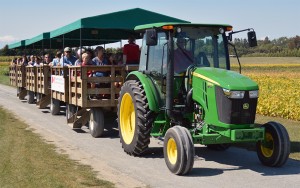Harrow Research and Development Centre open house

A John Deere tractor pulls three covered wagons on a trail through field plots — while a research scientist acts as a tour guide — at the Harrow Research and Development Centre open house on Saturday, Sept. 16 in Harrow, ON. (Photo by Ken Pastushyn)
By Kenneth Pastushyn
People were able to learn about the agricultural activities the Harrow Research and Development Centre has to offer at its open house.
Visitors took guided tours on a covered wagon pulled by a John Deere tractor. The annual event took place Sept. 16. Each tour lasted approximately 25 minutes travelling on a bumpy three-kilometre trail of field plots while a narrator in front described the research being conducted.
“We are here to celebrate Canada’s 150th anniversary which Agriculture and Agri-Food Canada is a part of,” said Tom Welacky, one of 16 scientists at the Harrow facility.
Welacky works on soil and specializes in trying to control nematodes, those pesky white worms destroying soybean crops. Welacky was also one of six narrators on the tour.
“We are one of the more larger active research facilities in Ontario…but don’t tell Ottawa that,” said Lori Phillips — a soil microbiologist at the Harrow research centre and another tour guide — referring to the Central Experimental Farm in the National Capital Region. Harrow is one of 20 experimental farms across Canada.
“I am producing – not crops – but knowledge,” said Phillips, who analyzes soil under a microscope to
make sure it is full of nutrients. “Most of the work we do is collaborative, part of many national and
international programs.”
One example Phillips used is purposely over-watering plants with a complex sprinkler system in a plot
full of soybeans and sunflowers. This tests their resistance to white mold disease.
“We do things most farmers in their right minds would not do,” said Eric Page, a tour guide and
research scientist who specializes in weeds and diseases — and how to stop them from spreading.
“That’s how we help farmers.”
Another way the research centre is helping farmers and the refineries in Sarnia is by devoting a
plot to focus on corn stover removal. Corn stover is the stock and leaves left over after the ear has been
removed. The roots of the stover stays in the soil, while the stock and the leaves can be used to produce
ethanol, a clean energy burning fuel source.
“If you take out too much corn stover, crop production can decrease,” said Craig Drury, another tour
guide and soil biochemist who tests it for environmental quality. “What we are trying to do is to have an
idea of how much corn stover residue to remove for bio-fuels and keep it in the ground to crop yield.”
The Harrow research centre also planted rows of hazelnut trees for Ferraro-Rocher, the maker of Nutella
chocolate-hazelnut spread, which also has a plant outside of Toronto.
“Ferraro wanted to increase their hazelnut production,” said Rob Nurse, a tour guide and weed scientist
specializing in pesticides, who also worked with Ferraro to produce the nuts. “Harrow is an ideal place to
grow hazelnuts.”
Near the end of the tour is a soybean breeding plot to produce high-quality tofu products for the Asian
market. The Harrow soybean is a popular variety which has been produced since 1950 and in 1989 the
Harovinton variety was developed.
“The Asian people call it ‘the pearl’ because it is the standard of food grade tofu,” said Al Hamill, a
former weed scientist who retired 11 years ago from the Harrow research centre. He keeps coming back
to conduct tours during the open house. “I was employed here for 37 years and I never felt like I worked
here a day in my life.”


